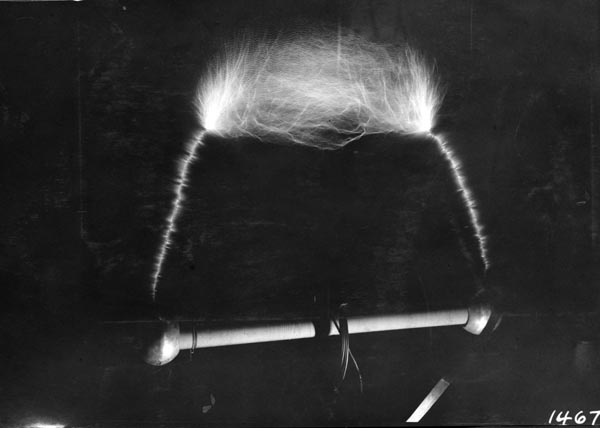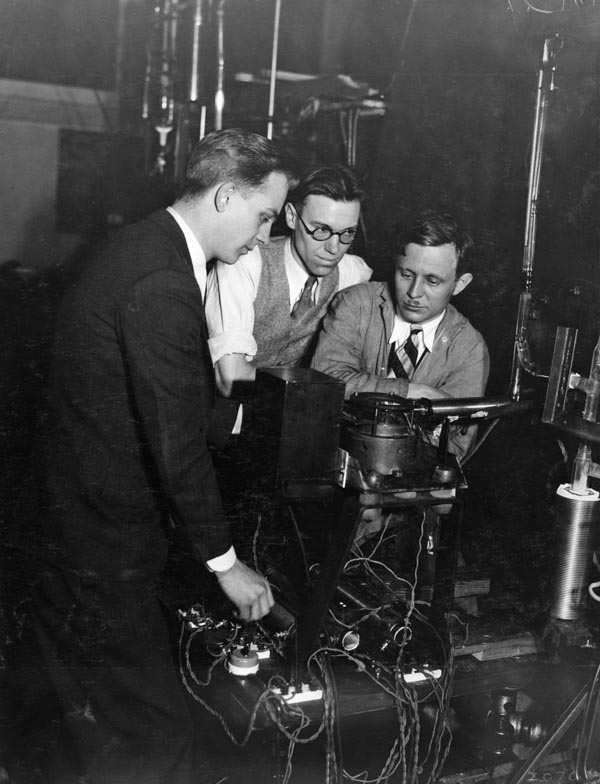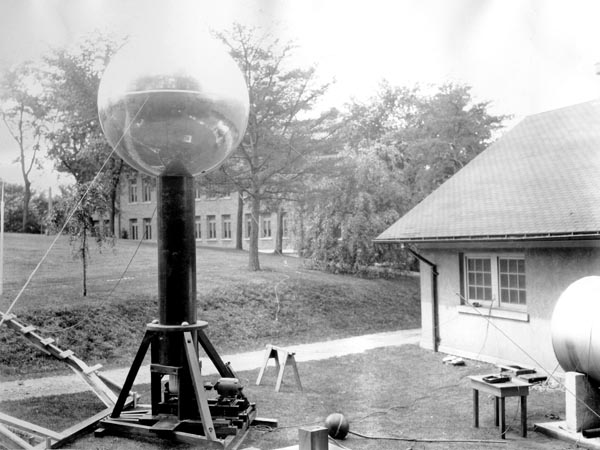Atomic Physics
 |
| Sparking Tesla coil in air, representing a voltage between 500,000 and 750,000 volts, Image No. 1467. |
 |
|
| Dr. Gaviola and Dr. Tuve with vacuum tubes designed for high-voltage experiments in 1928, Image No. I1433. |
As their interest in ionospheric sounding experiments waned, the Department of Terrestrial Magnetism physicists Gregory Breit and Merle Tuve directed their attention to high voltage atomic physics in 1926. A Press Service Bulletin entitled “Shattering the Atom,” released in 1928, summarized the logic behind a research facility devoted to magnetism undertaking high voltage physics research, saying, DTM “has undertaken this work in the hope of extending knowledge of the nature of matter upon which any fundamental understanding of magnetism and therefore of the phenomena of terrestrial magnetism must rest.” The instruments and apparatus that resulted from DTM’s high voltage experiments are well recorded in the photograph collection.
With the approval of new DTM director, John Fleming, Tuve and Breit set about developing a stable electromagnetic source of alpha particles which could then be accelerated through an electric potential of millions of volts. This particle accelerator could then be used to study the atomic nucleus, replacing expensive and problematic radioactive sources of alpha particles used in earlier research. Tuve’s background in electrical engineering and Breit’s grasp of theory were well suited to the high voltage experiments, and the team began their work with the Telsa transformer.
 |
|
Merle Tuve, Lawrence Hafstad, and Odd Dahl with a cloud chamber for high voltage work in 1931, Image No. I2070. |
The Telsa transformer seemed the logical apparatus with which to start the experiments as it was relatively inexpensive to construct and was capable of generating potentials of tens of kilovolts. The transformer, however, produced alternating potentials and, because it used a spark oscillator, the device had a very short duty cycle, which is the time in which the alternating voltage occurs. Despite these limitations, Breit and Tuve generated 5 MV in 1928 by placing the coil in pressurized oil.
 |
| Two-meter Van de Graaff electrostatic generator set up outside Experiment Building in 1932 used to determine maximum obtainable voltage and fluctuation limits, Image No. I2655. |
Due to the inherent limitations of the Tesla coil, particularly the problem of needing vacuum tubes capable of withstanding the high voltages applied to them, the group’s progress stalled after the initial successes. Concurrent with the project, however, the team, which then included DTM scientists Lawrence Hafstad and Odd Dahl as Breit left DTM in 1928, made significant progress improving other apparatus useful to the atomic physics work. Of note is their work with Wilson cloud-chambers, ionization chambers, and electrometer tubes.
In 1931, the DTM atomic physics team learned of Robert Van de Graaff’s new electrostatic generator, and Tuve arranged for Van de Graaff to visit DTM to study the potential of the generator as a high-voltage accelerator. The vacuum tubes designed for the Tesla coils sustained the 600 kV potentials applied to them without difficulty. Encouraged by the success of the accelerator tube, the team arranged for an aluminum sphere with a 2 meter diameter to be constructed for an electrode in order study the voltage capabilities of the Van de Graaff apparatus. The photograph collection contains images of this generator as it was assembled outside behind DTM’s main building.
 |
| The observing room underneath the 2-meter Van de Graaff accelerator in 1935, Image No. I3584. |
The outdoor generator achieved potentials above 1 MV while the accelerator tube held the voltages. After this accomplishment, the Experiment Building was expanded to house a 2 meter generator while a smaller 1-meter generator was also constructed for the study and improvement of accelerator design. The photograph collection documents the improvements as they were made to the generators. In 1935, R. Herb of the University of Wisconsin designed a large resistor for the 2-meter generator so that the accelerating voltage could be determined and controlled. The collection also includes photographs of the construction and schematics of the Atomic Physics Observatory (APO), built to house an electrostatic generator inside a large pressure tank which would permit even higher voltages. In 1940, DTM built a 60-inch cyclotron, modeled after the Berkeley cyclotron designed by Ernest Lawrence.
The high-voltage equipment used at DTM was utilized for multiple significant experiments in atomic and nuclear physics. With the Van de Graaff accelerators, Tuve, Hafstad, and fellow DTM scientist Norman Heydenburg conducted proton-proton and proton-neutron scattering experiments in the 1930s which led to the understanding that the nuclear force between nucleons is attractive and identical. On January 28, 1939, the nuclear physics group used the pressure-tank Van de Graaff in the APO for a demonstration of uranium fission, among the first such demonstrations in the United States. The instrument photograph collection documents the high voltage experiments from the early Tesla coils until the termination of the instrument photograph collection in 1956. DTM shut down the cyclotron in 1957 while the APO Van de Graaff continued in use until 1975.
